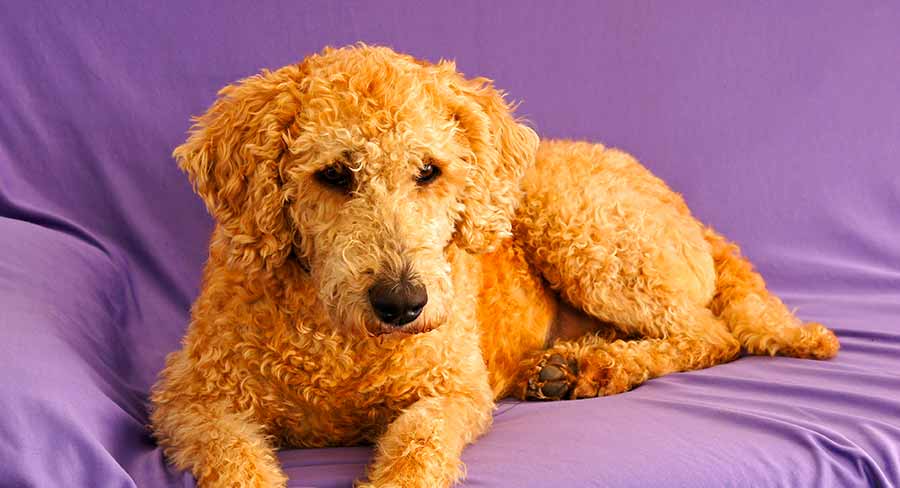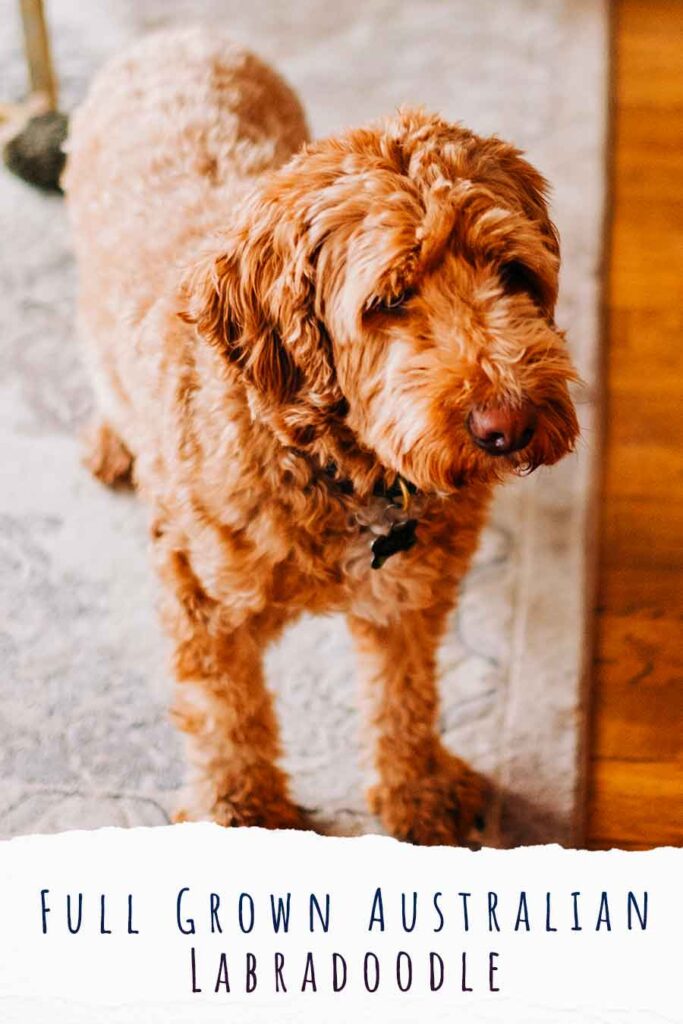
Do you know how big a full grown Australian Labradoodle will get, and how much food, exercise and training they will need? In this complete guide to adult Aussie Labradoodles, we take a look at their size, and all aspects of their care.
A full grown Labradoodle can weigh anything between 15 and 65 pounds, depending upon which size category they belong to. They are 14 to 24 inches tall from the ground to the top of their shoulder blades. Their size will also affect how much food and exercise they need. But all Aussie Labradoodles need lots of ongoing training.
Full Grown Australian Labradoodle
Australian Labradoodles are distinct from first generation Labradoodles because they have been developed to ‘breed true’. Plain ‘Labradoodles’ are mixed breed dogs with one Labrador parent, one Poodle parent, and no breed standard. But ‘Australian Labradoodles’ have several generations of Labradoodle ancestors, and should reliably fit the breed standard written by the Worldwide Australian Labradoodle Association. In other words, Australian Labradoodle breeders are trying to harness the desirable qualities of the Labradoodle mix, in a new pedigree dog.
In this article, we’ll look at
- When is an Australian Labradoodle Fully Grown?
- Full Grown Australian Labradoodle Sizes
- Feeding your Adult Australian Labradoodle
- Exercising your Adult Australian Labradoodle
- Full Grown Australian Labradoodle Training
So let’s fast forward in time, and take a look at when your cuddly Australian doodle puppy is going to finally be fully grown.
When are Australian Labradoodle Puppies Fully Grown?
All dog types go through a period of very rapid growth in their first 6 to 8 months. After that, the rate they grow at starts to slow down. Generally speaking, the larger the dog, the longer it takes before their growth levels off completely, and they remain at their full adult size.
This is true of the different Australian Labradoodle sizes too. A Miniature Labradoodle can weigh as little as 15 pounds, and achieve almost all of that by the time they’re 9 or 10 months old. Meanwhile, a full grown Standard Aussie Doodle can weigh up to 65 pounds, but take over a year to get there.
There’s also a sex difference Australian Labradoodle puppy growth. Male puppies tend to grow more rapidly and stop growing more suddenly than females. Female puppies grow at a slightly more gradual rate, and their growth tails off more gradually as they reach maturity. But, they both reach full size around the same time.
By the time they’re a year old, Australian Labradoodles of all sizes are likely to have reached their full adult height. But they may continue to fill out and put on muscle weight for longer.

How Big Do Labradoodles Get?
A full grown Australian Labradoodle belongs to one of three distinct size categories:
- Standard
- Medium
- Miniature
Standard Adult Labradoodle Size
The Standard Australian Labradoodle is the largest size. Fully grown, these dogs will range from 21 to 24 inches tall at the top of their shoulder blades, and weigh up to 65 pounds. The Australian Labradoodle breed standard specifically allows for service dogs to be even bigger. This enables them to assist with mobility tasks such as help their owner out of chairs.
Male Standard Labradoodles typically grow taller, and weigh more, than female Labradoodles.
Medium Labradoodle Size
Full grown Medium Australian Labradoodles range from 17 to 20 inches tall and weigh 30 to 45 pounds range. These dogs reach adult size by the time they’re approximately one year old, and the difference between the sexes is much less pronounced.
Mini Australian Labradoodle Size
The Mini Australian Labradoodle is the smallest size, ranging from 14 to 16 inches tall and weighing about 15 to 30 pounds. There is no discernable difference in size between the sexes.
You may also hear about Micro or Teacup Australian Labradoodles that are smaller still. These aren’t recognized by the official breed standard. But, breeders might try to achieve them by breeding very small Miniature dogs together, or cross breeding one to a Toy Poodle, and dishonestly or mistakenly ‘borrowing’ the Australian Labradoodle name.
Full Grown Australian Labradoodle Diet and Feeding
When your Aussie Labradoodle reaches their full adult size, they’ll no longer need extra daily calories to support growth as well as all the other energy requirements of being alive. Rather than managing this change purely by adjusting their portion size (which can leave them still feeling hungry at the end of every meal) most people also switch to an adult diet which is less calorie dense.
The best way to tell if your Australian Labrdoodle is maintaining a healthy adult weight is simply by looking at him. There should be an inward curve at his waist, and you should be able to feel his ribs under a thin layer of fat when you apply gentle pressure to his sides. To judge the ‘right’ amount of fat, make a fist and feel the space between your knuckles (where rings sit). This is about how your dog’s ribs should feel. Better still, ask a veterinarian to check them too!
How Much Exercise Do Full Grown Australian Labradoodles Need?
Australian Labradoodles of all sizes are athletic dogs that require plenty of exercise and adequate space. The Standard Australian Labradoodle needs at least 60 minutes of daily activity. Ideally, this means having a securely fenced backyard for them to play in, and enjoying running or taking long walks yourself.
The Medium Australian Labradoodle is a good choice for those who want smaller dog but with similar energy levels. They need a smaller crate, smaller bed, less food, etc, but they still have lots of stamina for days out, dog sports, and long hikes. They still need around an hour of daily exercise.
The Miniature Australian Labradoodle is most suitable for apartment living and typically requires a little less exercise than the larger sizes. But, they are still very playful and active dogs – definitely not couch potatoes!
Full Grown Australian Labradoodle Training
Hopefully your basic obedience training will be well established by the time your Australian Labradoodle is fully grown. But your training journey is still far from over! Lots of their good behaviors will still need proofing and reinforcing for the foreseeable future, to turn them into really reliable habits.
Australian Labradoodle temperament is also highly motivated to engage with people and work alongside them. Beside Labradors and Poodles, the Aussie Labradoodle breed also boasts ancestors such as the English Cocker Spaniel. So they are descended from lots of active, motivated working dogs! Which means they are highly intelligent and need lots of mental stimulation. Training for activities like field trials, gundog trials, agility and dock diving are great ways to provide this.
Your Full Grown Australian Labradoodle
Full grown Labradoodle weight depends upon which category they belong to, their sex, and the size of each of their parents. If your Aussie Doodle has celebrated their first birthday, the chances are they are very close to their full grown size now.
An adult Australian Labradoodle is a big time commitment in terms of exercise and training to meet their need for physical and mental stimulation. But you’ll be rewarded with an attentive and loyal companion, and a very special and rewarding bond!
Do You Have A Full Grown Australian Labradoodle?
Do you have a big Labradoodle, or a small one? Please tell us more about them in the comments box down below!
References and Resources
Buzhardt. Body Condition Scores. VCA Animal Hospitals. Accessed October 2021.
Worldwide Australian Labradoodle Association
Cutrignelli. Dog nutritional management in the first year of life. A tool for preventing some skeletal problems. Animali da Compagnia. 2010.
Salt et al. Growth standard charts for monitoring bodyweight in dogs of different sizes. PLoS One. 2017.

Leave a Reply